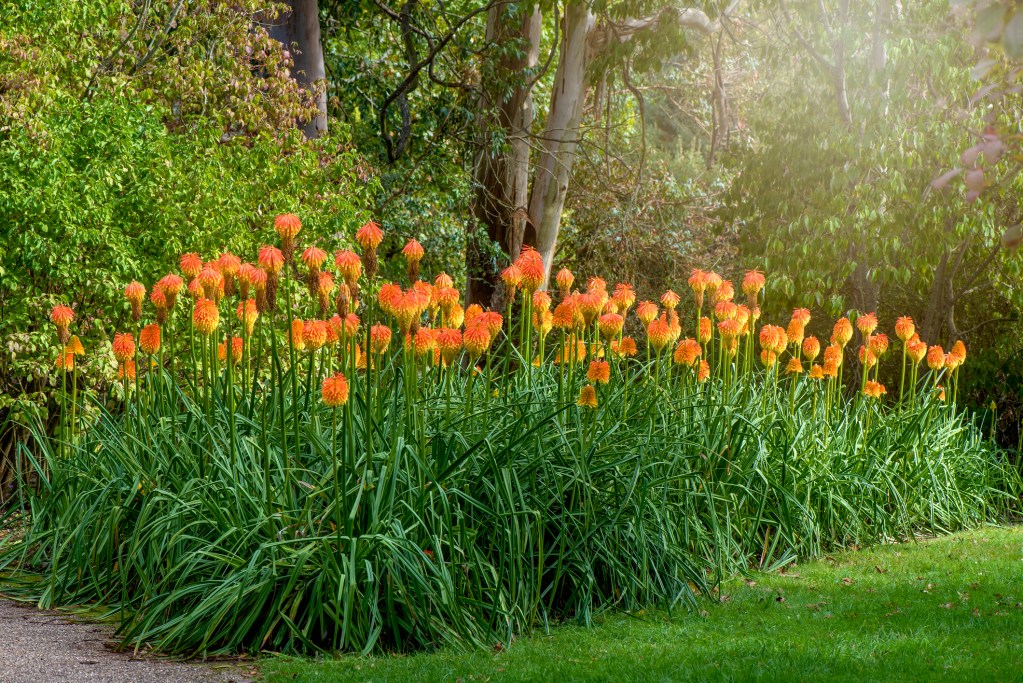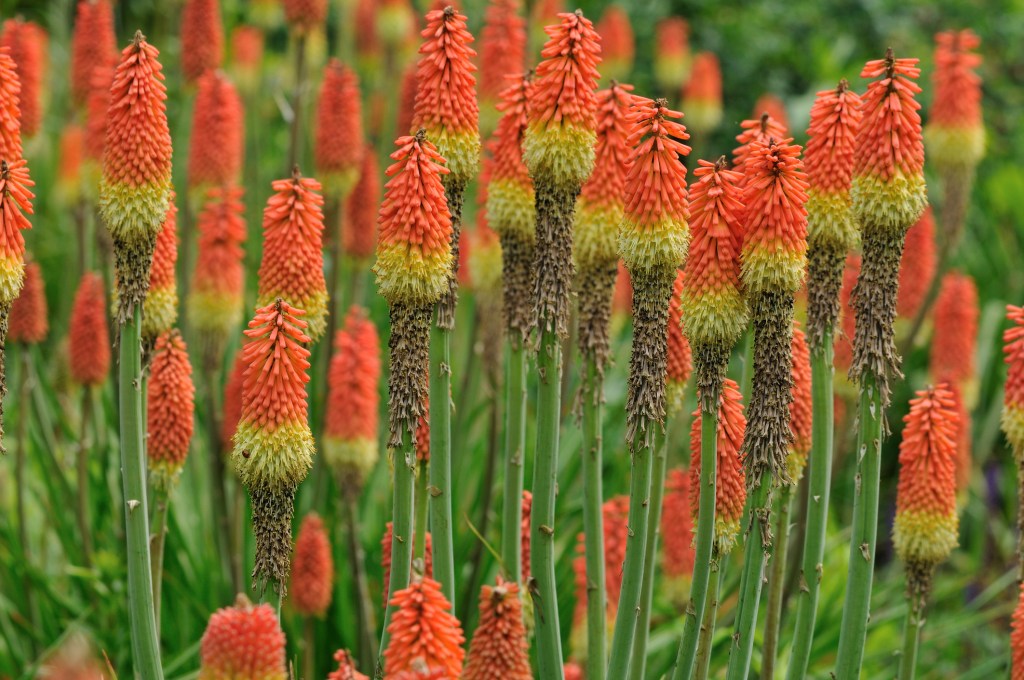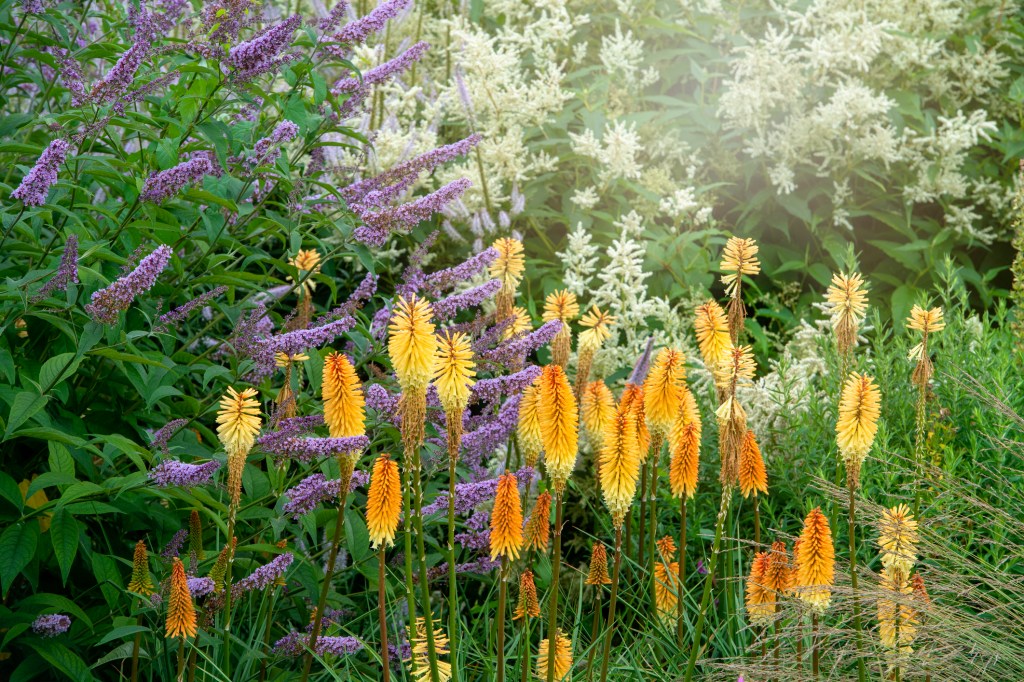If you’re looking for a stunning centerpiece that will be sure to turn heads, then look no further than Kniphofia (genus), also known as red hot pokers or torch lilies. These gorgeous perennials have long, draping leaves and tall flower stalks. Their height alone can be enough to catch someone’s eye, but the real show is their flowers. They bloom in brilliant shades of orange, red, and yellow, with a rounded, tapering shape. They resemble torches, fire pokers, or even phoenix feathers.
If you’re interested in adding this amazing plant to your garden, then this guide is for you. Here’s everything you need to know about red hot poker plant care.
Planting red hot pokers
The best time to plant young red hot poker plants or seeds is in early spring. Wait until the last frost of the year has passed before planting young plants. You can plant mature torch lilies at any time, but it’s best to plant them in spring. They bloom during the summer, so it’s important to get them in the ground before then, or you’ll have to wait until next year to see the flower. However, due to their mature size, adult torch lilies are less common to plant.
Kniphofia tolerates many soil types, but it performs best in soil that is rich in organic matter. The most important aspect of soil for this plant’s health is drainage. Red hot pokers don’t tolerate wet feet, so well-draining soil is critical. When planting your torch lilies, make sure to space them far apart. Kniphofia typically grows to be 2 to 4 feet tall and between 1 and 3 feet wide. They take up a lot of space, so be careful not to crowd them.

Caring for red hot pokers
Red hot pokers need surprisingly minimal care. They are drought-resistant plants and require very little supplemental watering. In rainy seasons, you may not need to water them at all. During hot, dry weather, you should water your torch lilies roughly once a week. Soak the soil thoroughly, but if the soil is still damp from the previous watering, you shouldn’t water it.
During the winter, kniphofia goes dormant. You can remove any dead flower stalks during winter to help minimize cold damage. You can tie the leaves up, almost like giving your plant a ponytail. This helps protect the more sensitive interior of the plant by using the leaves as a barrier of sorts. You can also cut the leaves down to ground level. As a perennial, Kniphofia will grow back in the spring.
If your red hot pokers are in poor soil or have been growing in the same area for a long time without fertilizer, then feeding your plant may improve their overall health. Stick to a fertilizer that is natural and contains organic matter, such as compost or leaf mulch.

Common problems and solutions
Despite their tall stalks, torch lilies don’t typically require staking. However, high winds can damage them. Providing a windbreak, so the full force of the wind doesn’t hit your kniphofia can be helpful. This is especially true during the winter, when it’s already vulnerable to the cold.
Kniphofia is resistant to most pests and diseases, so you shouldn’t worry too much about pest control. Slugs and snails can occasionally bother red hot pokers, but they rarely cause severe damage. This plant can develop root rot if it’s overwatered or planted in poorly draining soil. Treat root rot by trimming off the rotten roots and replanting the plant in clean, dry soil. Due to the mature size of these plants, however, this can be difficult to accomplish.
Red hot pokers may have smaller, fewer, or duller blooms if they receive too much shade. Avoid planting your torch lilies in the shade. If you plant them too close to the shade, they may eventually spread into the shaded area. Accounting for the mature size when planting can eliminate this problem.

Companion planting
You can use torch lilies in many different ways. They make stunning borders or centerpieces, and they pair well with both organized gardens and more natural ones. These plants are particularly great in pollinator gardens, as hummingbirds and butterflies love red hot pokers.
For a stunning combination, pair kniphofia with other tall flowers, such as allium, spider lilies, and lupine. Adding some yarrow or Queen Anne’s lace can soften the effect, incorporating a touch of delicate white to the bright colors. Space everything appropriately to avoid crowding your red hot pokers.
These fiery beauties certainly earn their names. Now that you know how to properly plant, care for, and work with these flowery torches, you’re ready to brighten up your yard with kniphofia. Plant them a few feet away from other plants or shaded areas and let the soil dry some before watering. Most pests won’t bother torch lilies, but butterflies and hummingbirds will be glad to see them. Enjoy your bright new garden addition!
Editors' Recommendations
- Plant these stunning flowering shrubs for a showstopping garden display this spring
- 3 incredible reasons why you should be using coffee grounds in your garden
- Have a gross mealybug infestation on your plants? Try one of these remedies
- Unique and whimsical flowers to add to your collection for a fairy-tale garden landscape this spring
- Why mulching might be the best option for your old Christmas tree




